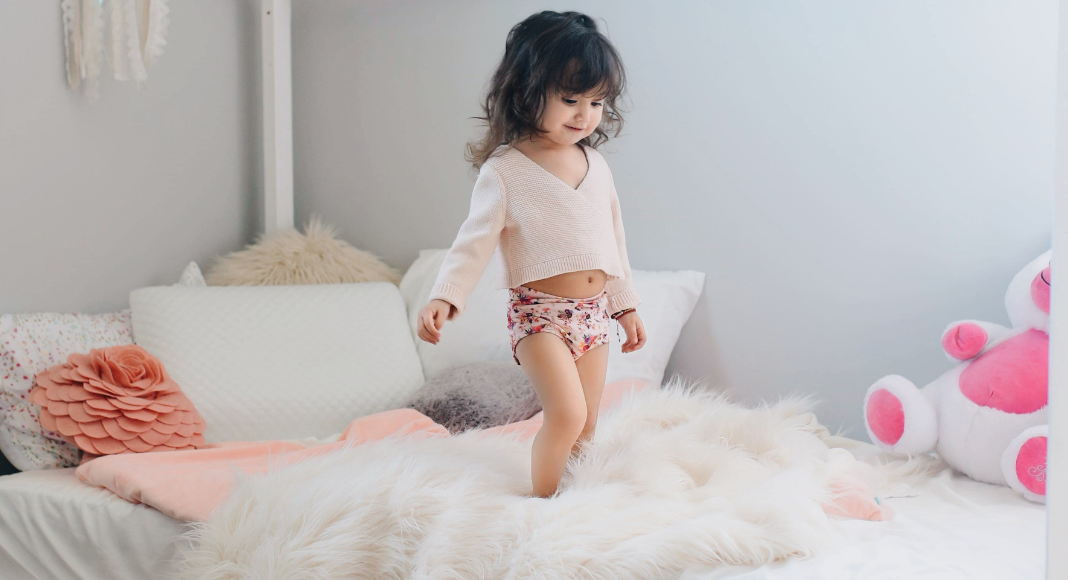 Transitioning from a crib to a bed is a major milestone in your child’s life – and in yours, too! If you’re thinking about making the switch, here are my top 10 tips for a smooth transition.
Transitioning from a crib to a bed is a major milestone in your child’s life – and in yours, too! If you’re thinking about making the switch, here are my top 10 tips for a smooth transition.
1. Make sure your child is developmentally ready.
Most children aren’t ready to handle the freedom of a big bed until at least two-and-a-half or three years of age. Why? Because until then, most children don’t have the cognitive ability to understand that they need to stay in their bed all night long. Expecting them to stay put is asking them to do something they’re just not capable of doing. This means there’s a good chance you’ll be walking them back to bed multiple times each night. If you think you have no choice because your child is climbing out of their crib, check out my article on how to discourage climbing. Doing everything you can to keep your child in their crib until they’re truly ready for the transition takes work but is well worth the time and energy you invest.
2. If it isn’t broke, don’t fix it!
If your child is developmentally ready for a big bed but is still happy in their crib, don’t push for a change! As long as they don’t exceed the height and weight limit, there’s no reason to move them until they physically outgrow the space. Don’t be swayed by friends or family that think you’re doing your child a disservice by waiting. A good night’s sleep is the best way to ensure that your child continues to grow and thrive.
3. Choose the right time.
Too much change all at once can be just as stressful as it is for adults. Significant events like starting school, the birth of a sibling, potty training, or moving to a new home are not a good time to introduce new sleeping arrangements. Avoid making the switch less than two or three months before or after the birth of a sibling, a month or two before or after school starts, or a month or two before or after moving to a new home.
4. Solve behavioral sleep problems first.
If your child hasn’t learned to put themselves to sleep and back to sleep without assistance, it’s a good idea to teach them how before you move them to a bed. Teaching sleep skills is much easier when your child is safely contained in their crib.
5. Talk about big beds in advance.
Most children do best with preparation. Introduce the idea of sleeping in a big bed gradually by talking about it before you plan to make a move. Books like Sesame Street’s “Big Enough For A Bed” and “Your Own Big Bed” by Rita M. Bergstein are great conversation starters and can help your child adjust gradually to the idea that a big bed is a wonderful, cozy place to sleep.
6. Offer choices.
You may not be comfortable allowing your child to select their new bed, but giving them an active role in the process, like allowing them to pick out the sheets, will help them feel invested and provide them with a sense of control over their new sleeping environment. If shopping for bedding isn’t their thing, take them shopping for a new stuffed animal to share their bed with instead. Be sure to remind them that there will be room in their big bed for all of the old comfort items that they already sleep with in their crib.
7. Make the room safe.
Keeping your child safe is a priority when they have the freedom that big beds allow. Be sure that all furniture, window treatments, windows, and electrical outlets are secure. Make sure that staircase gates are closed, and if you have a middle-of-the-night wanderer, consider gating their bedroom door at night to keep them safely inside. Make sure that new bed purchases meet the Consumer Products Safety Commission guidelines, and if you decide to skip the toddler bed and go for a standard twin or full, install rails on both sides of the bed to prevent tumbles – or place the mattress directly on the floor. Products like Beddy’s or Zip It Bedding are cozy and can help to keep children tucked in securely all night long.
8. Have a bedtime routine in place.
A consistent bedtime routine is a must for all children and is especially important during times of change. If you don’t have a good routine in place, be sure to establish one before you move your child to their big new bed. Adjusting a bit by adding a few minutes of snuggle time in the new bed before lights out is fine – be careful it doesn’t turn into a new habit like having to stay with them in their bed until they fall asleep.
9. Be patient.
It’s reasonable to expect that even the most adaptable children will need a few weeks of practice before they completely adjust to sleeping in their new bed. Be patient. If your child is anxious, let them know that you’ll be back to check on them and follow through with what you say. If they get out of bed to look for you, walk them back, tuck them in and remind them that it’s time to sleep and that you’ll check in again soon. Patience, reassurance, and consistency are the key to success.
10. Be flexible.
Although most children adjust to their big bed in two or three weeks, a small percentage will continue to struggle beyond what you might expect – and may even ask if they can go back to sleeping in their crib. If your child is showing signs of true distress, don’t be afraid to bring back the crib and try the big bed again at another time. Be sure to let your child know that it’s ok if they’re not quite ready and that you‘ll try again when the time is right.


























